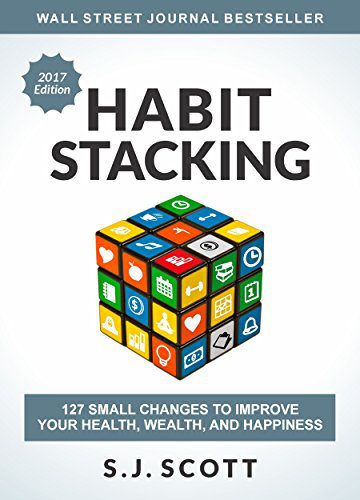One Routine + Multiple Habits = Habit Stacking
In Habit Stacking: 127 Small Changes to Improve Your Health, Wealth, and Happiness, author S.J. Scott describes the concept of habit stacking and how small changes can lead to considerable improvements in every area of life.
Overnight Success
Unfortunately, the story of the overnight success is nothing more than a myth. For every person who strikes it rich, there are thousands of folks who languish in obscurity. The cause of all this is the belief that success is an event. That you can transition from “zero to hero” without a lot of effort. That you can start as a nobody, get discovered by the right person who notices your unique talent, and suddenly skyrocket up the ranks of the rich and famous.
Success is always a process.
It’s a daily slog where most of your time is spent doing the same thing over and over. Rinse and repeat. Day in and day out. A few wins along the way, and then a few setbacks. Eventually, by working hard, and often for many, many years, you’ll become successful. That’s the reality of success. It’s not luck or an event—just a lot of hard work and daily action.
The Habit Stacking Process
1. Identify those small important actions (like writing a loving message to the important people in your life).
2. Group them together into a routine with equally important actions.
3. Schedule a specific time each day to complete this routine.
4. Use a trigger as a reminder to complete this stack.
5. Make it super easy to get started.
In essence, the goal here is to complete the habits that you know are important by stacking them on top of one another.
Habit stacking works because you eliminate the stress of adding too many new things to your life. Instead, you begin with a few simple but effective habits and then build on them as this routine becomes an important “can’t miss” part of your day.
This stack (and the others you build) will become as important as the routines you follow when you get up in the morning, prepare for work, and get ready to sleep.
The Importance of Goals
The best way to build a habit stack is to combine actions related to what you want from life. In other words, it makes no sense to add random habits together that have no personal meaning. Instead, each must align with your goals. This will make it easier to stick with a new habit stacking routine.
3 Types of Habits
1. Keystone habits
2. Support habits
3. Elephant habits
Keystone habits
A keystone habit can have a positive impact on multiple areas of your life—even if you’re not intentionally trying to improve them. A common example that people use is a thirty-minute daily exercise routine. Let’s say you start running to lose a few pounds. As you get fitter, you subconsciously start to avoid fatty and sugary foods, so your weight dramatically decreases. This improves your self-esteem, which creates a positive change in both your relationships and your career (because you now feel confident enough to ask for a raise).
On the surface, all you did was exercise for thirty minutes every day, but the addition of this single habit caused a chain reaction of positive results. That’s the essence of a keystone habit—it’s a single change that produces a positive trickledown effect in other areas of your life.
Support Habits
They support the achievement of an important keystone habit. Never underestimate the power of support habits. While they only take a few minutes to do, they are the glue that holds together your keystone habits.
Elephant Habits
Elephant habits are designed to overcome the natural resistance that we all feel whenever we’re forced to do a potentially unpleasant task. You know it must be done, but you avoid starting because dedicating a few days to it sounds as fun as getting a root canal.
When you tell yourself that a task “only” takes five minutes of your time, it’s easier to convince yourself to get started. And what usually happens is, once you get started, you’ll find yourself doing more of that activity than you originally planned.
All the Best in your quest to get Better. Don’t Settle: Live with Passion.



Comments are closed.